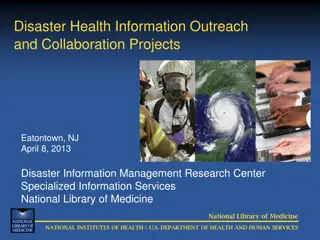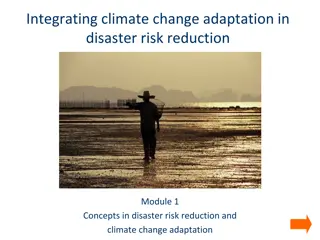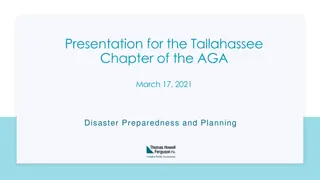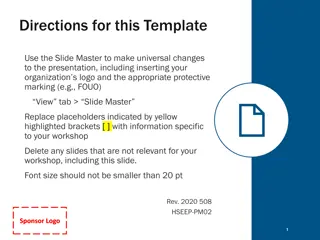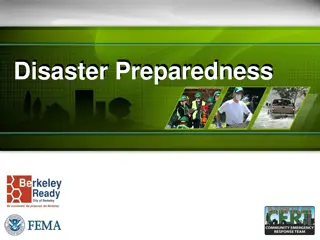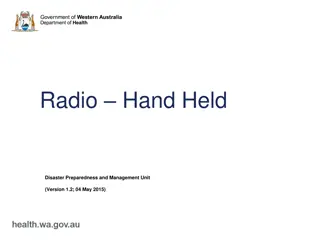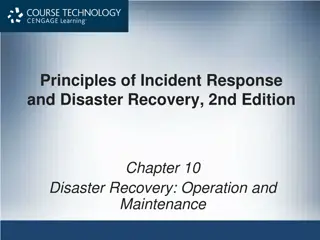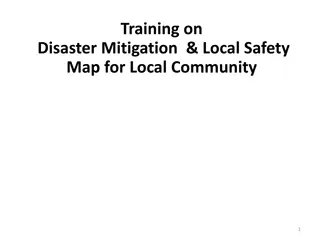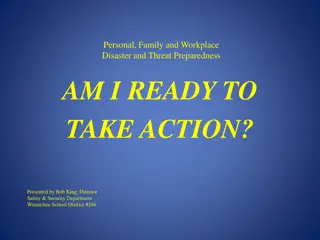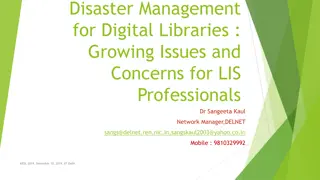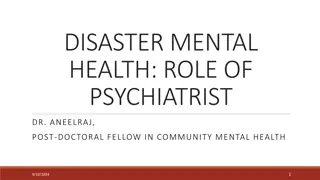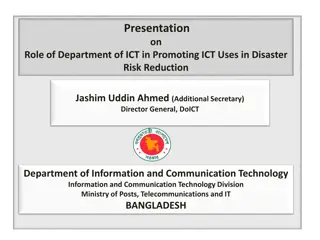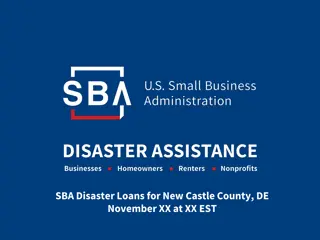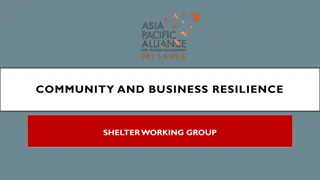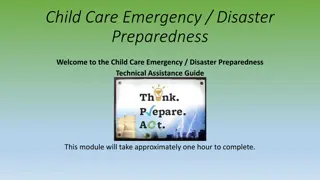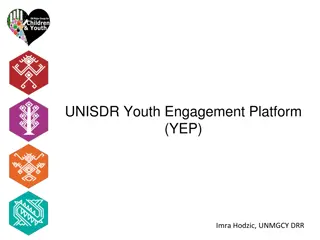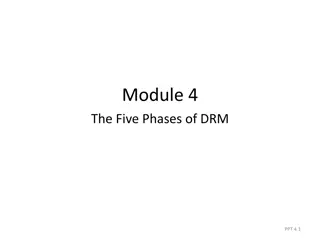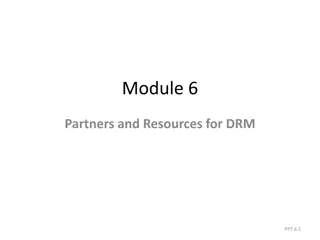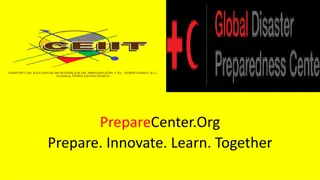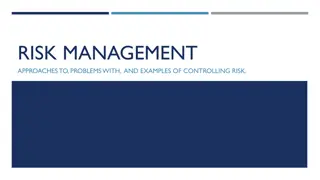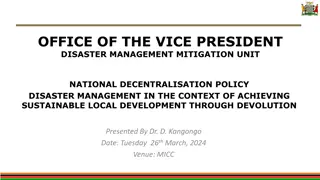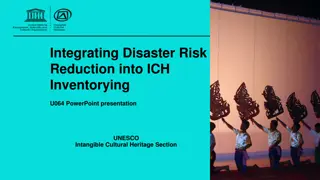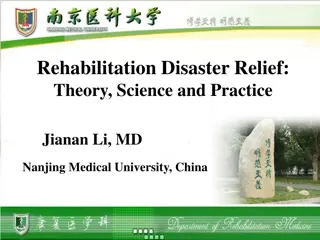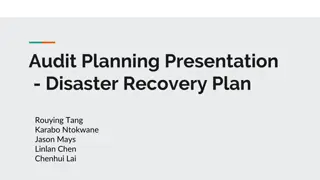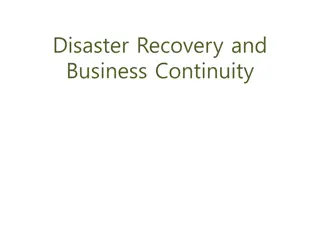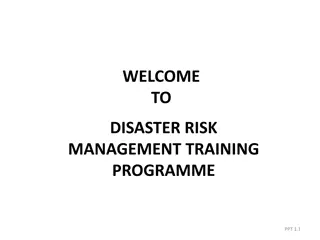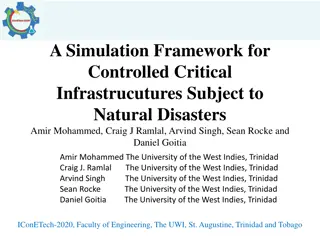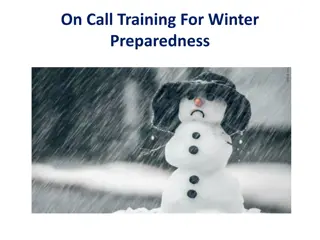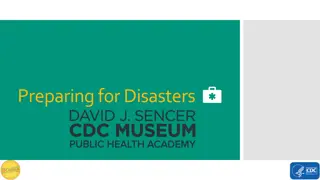Comprehensive Training Module on Natural Disaster Preparedness
In this comprehensive training module, participants will learn about various natural disasters, their causes, and characteristics. They will also be equipped with the necessary knowledge to prepare emergency procedures checklists tailored to different types of disasters. The module covers a range of common natural disasters like hurricanes, floods, earthquakes, and wildfires, providing valuable insights and practical guidelines for disaster preparedness and response.
Download Presentation

Please find below an Image/Link to download the presentation.
The content on the website is provided AS IS for your information and personal use only. It may not be sold, licensed, or shared on other websites without obtaining consent from the author. Download presentation by click this link. If you encounter any issues during the download, it is possible that the publisher has removed the file from their server.
E N D
Presentation Transcript
Module 7 Characters of Major Natural Disasters and Checklists for Each Disaster PPT 7.1
Module 7: Performance Objectives At the end of this module, trainees will be able to: describe various common natural disasters, their causes and characters prepare emergency procedures checklists, for headquarters and field units separately, that should be followed in general to face all kinds of disasters prepare similar emergency checklists to be followed in hazard- specific disaster cases like flood, tsunami, earthquake, hurricane, cyclone etc customise above emergency procedures checklists for their respective postal administrations keeping in mind the specific needs of such administrations PPT 7.2
Activities in this Module Go through the presentations Go through Appendix A & B of UPU Guide Prepare Emergency Procedures Checklists to face one hazard-specific disaster most likely to happen in respective administrations of the trainees Consolidate and compile various exercises carried on in last three days to prepare a draft DRM Plan (to face the above hazard-specific disaster) for respective administrations of the trainees Complete the Caribbean Region Hurricane and Flooding Exercise PPT 7.3
Various Natural Disasters: their Causes and Characters UPU DRM Guide Appendix A states in detail the causes and characters of following natural disasters Hurricane/ Cyclone/ Typhoon Flood Tropical Strom Tornado Earthquake Wildfire Tsunami Winter Storm Volcanic Eruption Trainees should go through Appendix A. PPT 7.4
Emergency Procedure Checklists to face natural disasters In UPU DRM Guide at Appendix B, separate checklists have been provided for following two types of cases (a) checklists common for all disasters (i.e. non-hazard specific) (b) checklists for hazard-specific disasters (flood, hurricane etc) PPT 7.5
Emergency Procedure Checklists common for all Disasters Checklists which are common for all disasters are also known as Critical Action Checklists. They are prepared for Headquarters and Field Units separately (Ref slides 7.6 to 7.9) These checklists have been prepared on the basis of industry best practices. Postal administrations should customise these checklists to suit their specific needs before adopting them. PPT 7.6
Emergency Procedure Checklists common for all Disasters (contd.) Checklists for Headquarters: Should cover procedures for: Contact/coordination with First Responders for assistance Evacuation of employees, rescue operations Accounting of all employees, both on-site and off-site, and injuries Checking damage to the structure of the HQ building Relocation of facilities, if required PPT 7.7
Emergency Procedure Checklists common for all Disasters (contd.) Checklists for Headquarters (contd.): Activation of EMT, EOC Checking if the event can escalate and cause further impacts Assessment of damages equipment Checking of main systems like water, power, gas, fuel Contact with facilities department for damage assessment and repairs to infrastructure, PPT 7.8
Emergency Procedures - common (contd.) Checklists for Headquarters (contd.) Continuous monitoring of media reports and weather reports Checking impact of the disaster on field units Communication with employees, vendors and providing them updates Updating key customers about the disruption in service Recording of all decisions and communications for future review Securing the HQ building and its assets Liaison with local/ postal police and law enforcement agencies as would be necessary PPT 7.9
Emergency Procedures common (contd.) Checklists for Field Units All points in the checklists as mentioned for HQ (PPT 7.7 - 7.9) plus the following: Take action to ensure that mail and postal assets are secured and there is minimum damage to mail or assets Similarly check if postal vehicles are in safe location Consider diversion of mail to other facilities not affected by disaster Communicate situation and impacts to next level management PPT 7.10
Emergency Procedures - common (contd.) Checklists for Field Units (contd.) Send 3P Reports regularly to HQ Consider shifting to an alternate site, if present one is not safe Activate Business Continuity Plan as needed Account for any customer that may have been in the facility at the time of disaster Communicate with customers if any operation is shifted to an alternate site Contact HQ safety staff for any assistance or guidance To go through Appendix B 1.1 B 1.8 and B 2.2 B 2.8 for more details. PPT 7.11
Emergency Procedures Checklists for Hazard-Specific Disasters Hazard-specific disasters are like Hurricane, Cyclone, Earthquake, Flood, Tsunami etc. Checklists are made for each disaster individually Again for each disaster, checklists are made for Headquarters and Field units separately (Refer to Appendix B of UPU Guide for the checklists) PPT 7.12
Emergency Procedures Checklists Hazard-Specific Disasters (contd.) Further, each such checklist (either for HQ or for Field Units) is required to spell out emergency procedures to be followed in the three phases of the disaster, namely for: Prior to and during the disaster (prior to & during 0 hours) Immediately after the disaster (0-48 hours) Post-disaster Recovery phase (48+ hours) Thus, 6 comprehensive checklists need to be prepared for each Disaster. PPT 7.13
Emergency Procedures Checklists Hazard-Specific Disasters (contd.) Appendix B lists the Emergency Procedures Checklists (also known as Tasks) for a number of specific disasters. The Checklists have been prepared out of industry best practices in various countries that faced disasters effectively. Many checklists or tasks are common to be followed in most hazard-specific disaster situations Checklists for two specific disasters viz. Earthquake and Hurricane/ Cyclone/ Typhoon have been explained in the following slides as examples Trainees should, however, go through all the checklists as provided in Appendix B applicable for various hazard-specific disaster situations PPT 7.14
Emergency Procedure Checklists for Earthquake PPT 7.15
Earthquake Emergency Procedure Checklists are prepared for (i) Headquarters and (ii) Field Units separately for following three phases, namely A. Actions prior to and during earthquake B. Response Procedures (0-48 hours) C. Recovery Actions (48+ hours) PPT 7.16
Earthquake Emergency Procedures Checklists for HQ A. Initial Critical Actions prior to and during earthquake (i.e. prior to & during 0 hours) 1. Ensure all corrective actions from previous season s after action reports are implemented 2. Activate EMT, EOC 3. Update emergency contact numbers 4. Instruct employees to move to Shelter In Place and to Drop, Cover and Hold On 5. Evacuate employees, customers through safe routes PPT 7.17
Earthquake Emergency Procedures Checklists for HQ (contd.) A. Initial Critical Actions prior to and during earthquake (i.e. prior to & during 0 hours) 6. Headcount employees to find missing and injured ones 7. Monitor TV, Radio and Local news for latest information 8. Turn off damaged utilities like gas, electricity, water etc. 9. Communicate with field units about the situation and provide assistance as required and possible 10. Ensure field units have plans in place to migrate their sorting programmes to alternate facilities 11. Document all decisions and communications for future review PPT 7.18
Earthquake Emergency Procedures Checklists for HQ (contd.) B. Response Procedures (0 48 Hours) 1. Activate EMT, EOC 2. Activate Business Continuity Plan 3. Provide emergency medical assistance to the injured 4. Prepare situational reports regularly and provide 3P Status 5. Following last of after shocks, conduct initial damage assessment 6. If required, relocate to a safe building PPT 7.19
Earthquake Emergency Procedures Checklists for HQ (contd.) B. Response Procedures (0 48 Hours) 7. Determine extent of power outages and identify need for emergency generator/ fuel 8. Check for any gas leak, electrical malfunctioning 9. Consider supplying Ready To Eat Meals and Drinking Water 10. Secure HQ building and postal assets 11. Keep employees informed about the situation 12. Monitor TV, radio and local news and follow local emergency guidance PPT 7.20
Earthquake Emergency Procedures Checklists for HQ (contd.) C. Recovery Actions (48+ hours) 1. Make a structural assessment of the HQ building before re- occupying 2. Focus initially on debris removal and repairs to damaged portions of the building 3. Shift to an alternate building if present one is not safe to occupy 4. Provide all support to field units for processing mails, change of address issues etc 5. Inform all employees about termination of emergency incident 6. Hold after action meeting with EMT staff to determine if plans, checklists, contacts etc need to be changed/ updated. PPT 7.21
Earthquake Emergency Procedures Checklists for Field Units A. Initial Critical Actions prior to and during earthquake (i.e. prior to & during 0 hours) 1. Ensure completion of all preparatory actions and inform next level management of any gap 2. Update all emergency contact numbers 3. Direct all employees to Shelter In Place and to Drop, Cover and Hold On 4. Account for all employees, both on-site and off-site, and of customers who may have been in the facility during the incident 5. Contact local authorities to know evacuation plan and follow to evacuate to a safe location PPT 7.22
Earthquake Emergency Procedures Checklists for Field Units (contd.) A. Initial Critical Actions prior to and during earthquake (i.e. prior to & during 0 hours) 6. Refresh current plant equipment inventory 7. Identify alternative facilities to migrate sorting programmes 8. Keep all generators ready and fuelled. 9. Park vehicles close side-by-side and front-to-rear to minimise damage, if possible 10. Follow TV, radio and local media for disaster updates 11. Contact local emergency to treat injuries 12. Document all meetings for subsequent review PPT 7.23
Earthquake Emergency Procedures Checklists for Field Units(contd.) B. Response Procedures (0-48 hours) 1. Ensure safety of employees 2. Secure all postal assets 3. Monitor national weather radios, TV, local news for updated information about the earthquake 4. Contact local maintenance for repairs to any damage in utilities like gas, water, electricity 5. Evacuate employees from damaged facilities to a safer place PPT 7.24
Earthquake Emergency Procedures Checklists for Field Units (contd.) B. Response Procedures (0 48 Hours) 6. Activate EMT to support assessment and communicate efforts 7. Check if mails need to be diverted to alternative facilities. Coordinate with next level on this 8. Perform initial damage assessment of the facility 9. Keep employees updated about the situation 10. Notify employees and customers of damaged and closed facilities PPT 7.25
Earthquake Emergency Procedures Checklists for Field Units (contd.) C. Recovery actions (48+ hours) 1. Coordinate with local authorities, maintenance department to know if it is safe to return to the damaged facility. Take up repairs before re-entry, if required 2. Contact next level to expedite repairs to facilities 3. If need be, shift operations to an alternate building 4. If mail was diverted or off-loaded to an alternative office, take action for their return PPT 7.26
Earthquake Emergency Procedures Checklists for Field Units (contd.) C. Recovery actions (48+ hours) 5. Update customers about the current service delivery status 6. Communicate termination of emergency to all staff 7. Hold meeting with EMT staff to determine if any change in plan, procedures necessary to face such emergency in future PPT 7.27
Emergency Procedures Checklists for Hurricane/ Cyclone/ Typhoon Like in Earthquake case, separate checklists are prepared for HQ & Field Units and for the three different phases PPT 7.28
Hurricane Emergency Checklists for HQ A. Initial Critical actions prior to and during Hurricane (i.e. prior to & during 0 hours) 1. Take all corrective actions as recommended in previous seasons after-action reports 2. Monitor weather alerts, media reports 3. Activate EMT/ EOC as required. Record all decisions/ communications made for subsequent review 4. Update HQ contact directory and all emergency contacts 5. Notify employees of evacuation routes, road closures, etc. Keep in touch with local authorities on these. PPT 7.29
Hurricane Emergency Checklists for HQ (contd.) A. Initial Critical actions prior to and during Hurricane (i.e. prior to & during 0 hours) 6. Depending on the track of hurricane, consider issuing a notice of HQ closure in advance as storm surge, heavy rainfall, flooding etc. may take place 7. Consider putting up barriers (sand bags, gravel bags etc.) if flood water, debris are likely to flow inside or around the building 8. Assist field units to shift to alternate sites as necessary 9. Refuel vehicles and park them on pre-defined higher ground positions 10. Secure assets including mail, stamps, money, records, electronic equipment to limit damage PPT 7.30
Hurricane Emergency Checklists for HQ (contd.) A. Initial Critical actions prior to and during Hurricane (i.e. prior to & during 0 hours) 11. Advise field units of the situation and provide status as required 12. Ensure there is a process to take collection boxes out of service in areas likely to be impacted 13. Ensure field units have plans for emergency refueling of vehicles, emergency generators, parking of vehicles on higher ground 14. Ensure field units have plans in place to migrate their sorting programmes to alternate facilities PPT 7.31
Hurricane Emergency Checklists for HQ (contd.) B. Response Procedures (0-48 hours) 1. HQ (EMT) should determine the boundaries of affected areas to focus on them 2. Ensure safety of employees including those involved with response procedures 3. Consider supplies of meals, drinking water to EMT initially, and for employees if sheltered in place 4. Secure postal assets (mail, vehicles, stamps, money) 5. Follow local emergency guidance, radio/television reports PPT 7.32
Hurricane Emergency Checklists for HQ (contd.) B. Response Procedures (0-48 hours) 6. Prepare situational reports regularly and provide 3P status 7. If damage to HQ building is severe, shift to alternative site. Inform field units, stakeholders. 8. Activate Business Continuity Plan (BCP) 9. Establish communications with field units through mobile/ telephone/ SMS/ satellite phones. Share emergency hotline numbers. 10. Conduct initial damage assessment 11. Identify need for emergency generators/ fuel PPT 7.33
Hurricane Emergency Checklists for HQ (contd.) C. Recovery Actions (48+ hours) 1. Coordinate with local authorities, structural engineers, facilities maintenance, postal police, etc. if HQ building is safe to return to service 2. Cover broken windows, torn roofs as required 3. Clean up/ decontaminate/ dehumidify HQ building before re- entry 4. Develop a plan for return of HQ employees from alternate sites 5. Maintain accurate records of all recovery costs for insurance purposes PPT 7.34
Hurricane Emergency Checklists for HQ (contd.) C. Recovery Actions (48+ hours) 6. Provide support to field units in processing of mails and delivery, processing change-of-address requests, and in all restoration efforts 7. Mobilize mobile units for collection and delivery of mail 8. EOC (Emergency Operations Center) staff to coordinate all recovery actions 9. Ensure termination of emergency incident is communicated to all staff 10. Coordinate after-action meeting(s) with EMT to determine if plans, procedures, contacts need to be updated or changed. PPT 7.35
Hurricane Emergency Checklists for Field Units A. Initial Critical Actions Prior to and During Hurricane Event 1. Monitor weather alerts and media reports about the situation 2. Ensure completion of relevant preparedness activities and inform HQ of any gap 3. Keep in touch with local authorities about evacuation plan 4. Update all emergency contact numbers, including power and utilities. Call them for any assistance. 5. Refresh current plant equipment inventory 6. Review equipment power down and support system procedures. Power down equipment, etc. when necessary. PPT 7.36
Hurricane Emergency Checklists for Field Units (contd.) A. Initial Critical Actions Prior to and During Hurricane Event 7. Park vehicles (close side to side and front to rear) to minimize damage. If necessary relocate vehicles to higher ground from flood prone areas. 8. Ensure all generators are operational and fuel 9. Ensure there is a process to take collection boxes out of service in areas likely to be impacted 10. Secure loose outdoor items and move them to elevated areas, if needed 11. Identify alternative facilitates to migrate sorting programmes 12. Move mail transport equipment from forecasted impact areas to neutral territory PPT 7.37
Hurricane Emergency Checklists for Field Units (contd.) A. Initial Critical Actions Prior to and During Hurricane Event 13. Ensure mail processing centers have a plan for emergency fueling, if fuel is not available at local outlets 14. Headcount all employees onsite and consider methods to contact off-duty employees about their well-being 15. Instruct all employees to stay clear of any window and exterior doorways 16. If facility damage occurs, have emergency evacuation team check for safe exits before releasing employees from Shelter In Place (SIP) location 17. Ensure decisions in all EMT/EOC are documented from subsequent reviews PPT 7.38
Hurricane Emergency Checklists for Field Units (contd.) B. Response Procedures (0-48 hours) 1. Monitor radio/local news, other resources for updated information, e.g., on mandatory evacuation, road closure, local shelters 2. Ensure safety of employees in all locations 3. Secure Postal assets (mail, vehicles, stamps, money) 4. Activate EMT. Assign a person to record and track all decisions. 5. Keep employees informed about the situation and direct them to report to alternate facilities, if necessary ppt 7.39 PPT 7.39
Hurricane Emergency Checklists for Field Units (contd.) B. Response Procedures (0-48 hours) 6. Ensure sending situational reports to HQ regularly and provide 3P status 7. Request large-facility generator support from HQ as necessary 8. Consider diversion of mail and staff to alternate operating facility 9. Conduct initial damage assessment 10. Notify employees and customers of closed facilties PPT 7.40
Hurricane Emergency Checklists for Field Units (contd.) C. Recovery Actions (48+ hours) 1. Coordinate with local authorities, facility maintenance staff, postal police, etc. if the postal facility is safe to return to service 2. Clean-up, repair the facility prior to re-entry. Request support from local resources and next level of management as needed. 3. Inform employees, unions of alternate operations plans and instruct them to report to alternate facilities as necessary 4. Track status and restoration efforts in respect of all essential mail processing and retailing operations. Maintain accurate records of restoration and recovery costs for insurance purposes. PPT 7.41
Hurricane Emergency Checklists for Field Units (contd.) B. Response Procedures (0-48 hours) 5. If mail was offloaded to alternate operating facility, develop plan for return of service to facility 6. Ensure termination of the emergency incident is communicated to all staff. 7. Coordinate after action meeting(s) and report with EMT to determine if plan, procedures, or contacts need to be updated or changed For more details on above checklists, refer to Appendix B of UPU DRM Guide. PPT 7.42
Checklists for Man-made disasters Postal sector also faces various man-made threats like terrorism, civil unrest, chemical spills, pandemic breaks etc. Applying the knowledge on disaster risk management for natural disasters and also about the emergency procedures checklists, trainees will be able to prepare emergency checklists for any man-made disaster as well. PPT 7.43
Exercise Procedures Checklists for a Specific Disaster on Preparation of Emergency Trainees will now carry out an exercise to prepare checklists for a specific natural disaster. The steps are: Identify the highest-risk threat (disaster) of their respective administrations from the Risk Grid. Prepare six checklists to face this disaster o 3 checklists for HQ for (i) prior to and during disaster phase, (ii) response phase and (iii) recovery phase o 3 checklists for field units for (i) prior to and during disaster phase, (ii) response phase and (iii) recovery phase Handout H 7.1 can be used to write down the checklists. PPT 7.44
Preparing a basic DRM Plan by consolidating results of various exercises Based on knowledge and skills learnt in this programme, trainees can also prepare a very basic DRM Plan for their administrations For this, they need to consolidate and compile results of following exercises carried out by them in last 3 days namely, Articulation of clear mission & objectives of DRM Plan (H 2.1) Vulnerability and Risk identification of the highest-risk threat (H 3.1) Activities to be carried out in 5 phases of DRM to face the highest-risk threat (H 4.2) Emergency Procedures Checklists (H 7.1), and The PDNA for a resilient recovery (H 5.1) assessments, Risk Grid & PPT 7.45
Preparing a basic DRM Plan by consolidating results of various exercises (contd.) The draft Plan will, however, need further development with inputs from country s senior postal managers & subject-matter experts. Following two slides explain the core elements of a proper DRM Plan. PPT 7.46
Preparing a DRM Plan The core elements of a DRM Plan are: Writing down clear mission, goals and objectives of the DRM Plan Vulnerability and risk analysis Assessment of capabilities of the organisation Engagement of senior management Making a realistic, flexible and adaptable programme Standard policies and activities to deal with the disasters in the five phases PPT 7.47
Preparing a DRM Plan (contd.) Integration of DRM with Business Continuity Plan Preparing a (continuous) Training and Exercise Plan Emergency Procedures checklists Carrying out an accurate & reliable PDNA for rehabilitation and recovery Preparing a framework for continual improvement and corrective action process. PPT 7.48
Progress Test Q 7.1 PPT 7.49
The Caribbean Region Hurricane and Flooding Exercise Trainees should now go through Handout H 7.2 and complete the exercise. Checklists at Appendix B can be used as job aid. This exercise will give them a very practical knowledge and exposure about disruptions that take place during a natural disaster and the activities that should be planned to face such a disaster. This exercise is a kind of Mastery Test & successful completion of this exercise will mean that trainees have understood the basics of DRM Plan and also learnt to use DRM tools successfully if a disaster takes place. PPT 7.50


